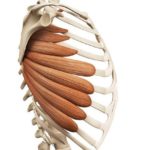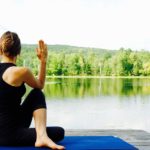Spine Mechanics:
How your spine moves or doesn’t move can really affect how powerful or effective your rowing stroke can be. Spine rotation to both sides without compensations and having full and uniform flexion and extension patterns are important mechanics to understand. How well you can move both pelvis and spine together to complete body angle for body over up the slide and your body angle at the finish is important. The relationship between hip mobility/pelvic mobility and spine is important and we will go into it further in the body mechanics post on the Hinge pattern.
Rotation affects technique more when it comes to sweep rowing in terms of amount of water per stroke, however maintaining rotation is a key self-care skill (Spine Mobility) for all rowers. Maintaining or working on spine rotation at each level, cervical, thoracic and lumbar help keep your back healthy and get the most out of your stroke. Here are a few areas of the rowing stroke affected by each spine region when it comes to rotation:
Cervical:
- Turning to check for traffic (Sculling)
Thoracic:
- Rib mobility
- Supports shoulder mobility to the catch and finish
- Rotation to rigger (sweeping)
- Turning to check for traffic (sculling)
Lumbar:
- Rotating to your rigger (sweeping)
- Adjust to set changes
- Turn and scull your partners oar at the starting line
- Plays a role in boat feel
Cervical spine aging changes are why a lot of masters rowers use visor mirrors to maintain safety on the water. The thoracic and lumbar spine play a more significant role in creating a healthy, sustainable rowing stroke. To be at its best, spine both needs to mobile and stable. To be stable enough to maintain a nice uniform curve for the catch and be able to handle the force produced through to finish.
Common Breakdown Points:
In general back injuries occur from over stressing one segment from not having good overall mobility or from not having enough stability to spread out the force created in a rowing stroke. The back, particularly the low back, has the highest rate of injury for rowers because of this difficult balance. Creating enough length in your stroke, while having enough integrity and strength to keep your spine and the surrounding muscles happy is the goal.
Everyone knows teammates and generally that rowers can have disc issues or SI joint issues or other wear and tear type pains in their backs that they row with all the time and just keep rowing. Now, this goes back to a main point I am hoping to get across, it is not OK to row in pain. When it comes to low back pain, there will be many posts relating to this topic, but, one place to start is to understand the proper mechanics and improve yours to the best of your ability.
How do I work on this?
More often than not, I find that understanding how much rotation your spine has and what that full range feels like, is missing in a lot of rowers, especially on your opposite side. For scullers I believe this happens because rotation is not used often, you are so good at using your spine for stability and the supporting muscles to prevent unwanted rotation that your body forgets how to go there. Using some of the mobility drills tagged in Spine Mobility can help you feel this, and even seeing how you look rotating in front of a mirror can be helpful. Give yourself the chance to see and feel what rotation you have, see the differences side to side and see what you might improve on.
How to look at your rotation:
Ideally when you stand with your feet together and rotate on side, your shoulders create a 90 degree angle with your hips. This looks at your full spine as one big picture. Isolating your thoracic spine and lumbar spine can be useful to learn more about yourself but as a start, try the big picture, can you get your shoulders to 90?
How to check flexion:
The Hinge mechanics post will go in detail here but generally, as we have referred to flexion, try and touch your toes.
How to check extension:
Standing with your hands on your hips or arms over head, bend backwards. This is a good test to see if you are hypermobile or prefer to bend through one area of your back more than others, you should be able to bend backwards without getting a pinching feeling in your back.
Being able to use the whole spine for flexion and extension can be challenging. Extension wise, you need to maintain a neutral spine at the finish without allowing your spine to go into extension or excessive flexion in any region. Having the appropriate supporting strength is key to control this. Otherwise mechanically we might see someone hyper extend in their low back to match the body angle of their boat mates or dump into the back of their pelvis too much. This makes you very heavy at the finish, loosing run. So work on your extension control and learn your active extension range, being aware of any pinching and trying to use a more uniform movement to avoid overloading one area.
As with all mechanics, the keys for being able to move well through any pattern are, strength and mobility!



